#including kofun's...situation
Photo

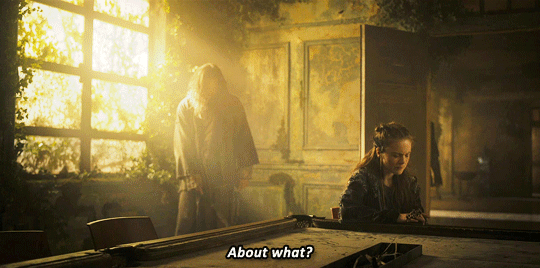

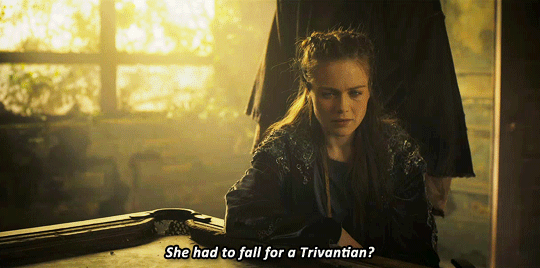

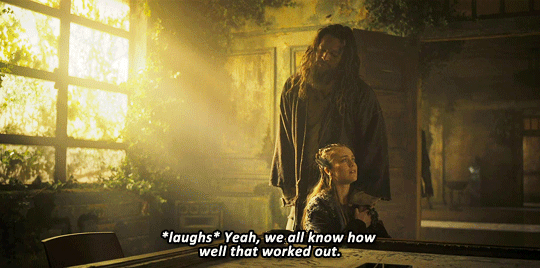
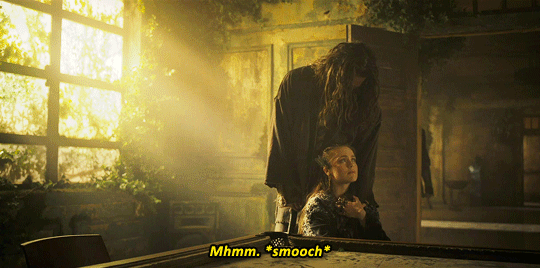
See (2019) - 3x03
#seeedit#see apple tv#baba voss#maghra kane#jason momoa#hera hilmar#see 3x03#haniwa x wren#femslash related stuff#of course I loved the inclusion of this#where baba who's known about wren for a while can chat with his wife about their kid's partner#the way any parents would#and maghra's faux annoyance at wren being a trivantian#but they're both mostly amused and relieved#considering wren already saved their lives#and seems conscientious and willing to betray her people to make sure bombs aren't used on haniwa's#and it's just nice to have this in the middle of everything else going on#including kofun's...situation#I'm still surprised how much wren's been used and included so far#and we know that haniwa's talked to charlotte about her since she let her go immediately#and tbh I still like the main family + charlotte + wren (+ bow lion + paris RIP)
258 notes
·
View notes
Text
Time for numbers (Part 2)
The second way of counting, the Chinese way, was simply borrowed from Middle Chinese. While we don't know exactly how they would have been pronounced, they have been reconstructed as the following:
1 一 /ʔiɪt̚/, 2 二 /ȵiɪH/, 3 三 /sɑm/, 4 四 /siɪH/, 5 五 /ŋuoX/, 6 六 /lɨuk̚/七, 7 /t͡sʰiɪt̚/, 8 八 /pˠɛt̚/, 9 九 /kɨuX/, 10 十 /d͡ʑiɪp̚/, 100 百 /pˠæk̚/, 1,000 千 /t͡sʰen/, 10,000 萬 /mʉɐnH/, 100,000,000 億 /ʔɨk̚/
although that last one could have also been 100,000 and in general just meant "a myriad" or "a whole lot". These entered Japanese and became:
1 一 /i.ti'/ or /i.tu'/, 2 二 /ni'/, 3 三 /sa.mu/, 4 四 /si'/, 5 五 /gwo'/?, 6 六 /rə.ku'/?, 七, 7 /si.ti'/, 8 八 /pa'.ti/, 9 九 /ku'/, 10 十 /ⁿzi'.pu/*, 100 百 /pja.ku'/?**, 1,000 千 /se'.n/?, 10,000 万 /mə'.n/?, 100,000,000 億 /ə'.ku/
All of this was borrowed over during the 5th and 6th centuries CE (Late Kofun through the Asuka periods), and were mostly connected with the cool new Buddhist religion that came over at the same time. So while some might be thinking, "Why even think about this? This is a conlang for cat YOUKAI, which are from Japan. Why would they have any reason to include CHINESE numbers?", there are actually 3 good reasons they would:
First, this occurred early in Japan's history and affected the language to this day.
Second, many of the folktales about kaibyou imply that they often lived at court or otherwise near nobles, with the exception of nekomata which were originally portrayed as demonic mountain cats. So it would make sense for some of them at least to know some Chinese.
Third, the precursor to kaibyou in folktales seems to be something called a 仙狸 JP senri or CH xiānlí, which was a leopard cat that could shape-shifting and use magic. So while kaibyou themselves are Japanese, their "ancestors" in a sense came over from China.
Part three we will finally get to what all this means for numbers in Nyango.
The Middle Chinese tones are called level (unmarked), checked (also unmarked but only on syllables ending in one of /p t k/), departing (marked with H) and rising (marked with X). It isn't certain what exactly these tones were, and while Mandarin also has four tones, they don't directly correlate to the Middle Chinese ones.
----
*Here we will discuss prenasalization! That little superscript n on /ⁿzi'.pu/ shows that the /z/ was prenasalized. And actually, due to the allophones of the plain and prenasalized series. (Allophones being different forms that phonemes take in different situations while still being perceived as the same sound.)
In Old Japanese, the plain sounds that have prenasalized counterparts are /p t s k/, and had unvoiced allophones at the beginnings of words but were likely voiced word internally. The prenasalized versions /ⁿb ⁿd ⁿz ⁿg/ were probably always voiced? But the important, distinguishing factor was the nasal onset. And we don't have time machine to travel back and pronounce a bunch of words at the Heian Japanese with unvoiced prenasalized consonants to see if they recognize them as weird prenasals or as unvoiced non-nasalized stops, but since prenasals were only found word internally in native words, we have pretty good evidence that the prenasalization was more important than the voicing. After borrowing terms from Middle Chinese, some words had prenasalization at the beginning of words, like /ⁿzi'.pu/ itself.
**Another change brought on by borrowing words from Middle Chinese was the inclusion of Cj and Cw clusters. Cw clusters have since been lost in Japanese, but Cj clusters are still in use, like in the descendant of /pja.ku'/, ひゃく /hja.ku/.
2 notes
·
View notes
Photo
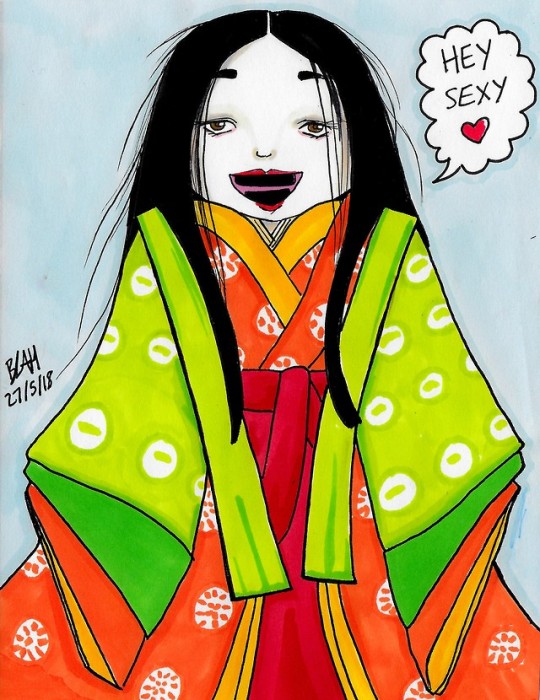
Unrealistic Standards of Women throughout History: Heian Japan 794-1185
Heian Japan is known for one of the most bizarre beauty trends in world history. Blacked out teeth. The Heian period is notable for its role in creating the art and literature that influenced Japan's culture for hundreds of years, however the fashion of the court presents a very different image to the refined and elegant one presented in Heian artwork.
First of all let's address those teeth! Blacked out teeth, or Ohaguro is not unique to Japan and has been practiced throughout southeast asia, particularly in China but is often associated most with Japan. You can see evidence of Ohaguro being used in Japan as early as the Kofun Period (250AD-538AD) and was still seen as a sign of beauty in the country up until the Meiji Period(1868-1912). The practice was particularly popular during Heian, one of the reasons being that the white rice powder women wore on their face would make their teeth appear yellow. Black teeth therefore was seen as more desirable. As strange as this may seem, blacked out teeth was not only fashionable but also helped to strengthen the teeth, protecting them from many dental issues. If it was still popular today perhaps we’d see beauty bloggers calling it a “beauty hack”. To achieve this look one would drink a mixture called kanemizu which contained iron filings, vinegar, tea, and rice wine, it smelled and tasted vile and so sometimes was seasoned with cloves and cinnamon. But this drink would only stain the teeth for a couple of days and so one had to keep on drinking it. Women weren’t the only ones who did this, however it was most popular among them.
Another somewhat odd beauty trend to a modern eye is how the Heian Court liked their eyebrows. Hikimayu was a practice where women would remove their eyebrows and then repaint them high on their forehead with their fingers in a smudge-like manner. They ink they used was called haizumi, made of soot from sesame and grape-seed oils. Like the teeth blackening, this was also in part because of the white power used on their faces, removing their eyebrows helped to apply the powder more easily, they were also influenced by the style of eyebrows in China at the time. Women also had to grow their hair as long as possible and it is thought that this style made the forehead too prominent so drawing the eyebrows higher up helped to address this issue.
Japanese women of the Heian Court were expected to wear layers and layers of kimono. These included a simple unlined dress hitoe, set of lined robes itsutsuginu/(kasane)uchigoe (in formal situations they would wear as many as 5 of these), a gown uchiginu, a mantle uwagi, a train mo, a jacket karaginu (In more casual situations the train and jacket would be replaced by an informal outer robe called a kouchigi) and finished with red trouser skirts nagabakana. It's hard to imagine how they could move with the weight of them all let alone survive in the heat of the Japanese summer.
Choice of pattern and colour were very important to the women that wore them, like fashion today these pieces were a way to express the wearers individuality. Womens character and style were judged by the clothes they wore.
Despite their extreme makeup routines and heavy garments, the women of the Heian court were pretty badass. In fact the first novel ever written was the Tale of Genji by Lady Murasaki, still considered a classic to this day. Japanese women were considered unworthy of learning the complicated chinese characters Kanji and instead used the phonetic alphabet Hiragana. Although this was meant to constrain women, it actually gave them an advantage against men when it came to the arts. It would take men a lifetime to learn how to read and write kanji, women on the otherhand were able to read and write hiragana in a matter of weeks. Heian is a very unique part of history because the majority of what we know is based on the diaries and works of women, we see history through their eyes.
So yes, beauty standards did make them look a bit silly by today's standards, but it didn’t stop them from expressing themselves!
If you want to learn more I do recommend reading Heian Diaries like Lady Murasaki’s, or the Gossamer Years. Its remarkable how these were written a thousand years ago, yet still feel relatable to this day!
#i got a bit carried away#i just find heian women so interesting#i would have written about the women in power at the time but i'll save that for another day#not sure what i think of the art style either#heian period#heian#heian japan#heian women#japan#japanese history#history of japan#world history#history#women of history#womens history#unrealistic expectations of women#blahart#beccalendsahand#my art#cartoon#comic#traditional#promarkers
11 notes
·
View notes
Text
Upcoming Jason Momoa Movies and TV Shows to Watch Out For
https://ift.tt/eA8V8J
Jason Momoa is everywhere. The former Game of Thrones actor is riding high after starring in the popular film Sweet Girl on Netflix, with Season 2 of his Apple TV+ series See set to start streaming this weekend and a key role in Denis Villeneuve’s hotly anticipated Dune adaptation on deck. Oh, and as the DCEU continues to shift and change, he’s still the only Arthur Curry, aka Aquaman, in sight. Not bad for a guy who got his start on Baywatch: Hawaii.
Things aren’t slowing down any time soon for Momoa. Besides the projects listed above, the actor has a few other big things planned down the road. If you just finished Netflix’s Sweet Girl and you’re looking for more Momoa in your life, here’s where you can expect to see the King of Atlantis next.
See Season 2
Streaming August 26
Apple TV+’s sci-fi dystopian series is set in a far-off future in which humanity collectively lost the sense of sight. Season 1 found Momoa’s Baba Voss reuniting with his sighted stepson Kofun (Archie Madekwe) after defeating Jerlamarel (Joshua Henry), another sighted man who had fathered kids like Kofun all while having a weird messiah complex.
In season 2, Momoa’s Baba will have to go toe-to-toe with another big bad preoccupied with the possibility of returning sight to the world, his brother Edo Voss, played by Dave Bautista. It’s clear from early looks of season 2 that there’s some bad blood between the hulking brothers, and with season 2 bringing in a new showrunner, Warrior‘s Jonathan Tropper, we can expect the action scenes to be even more explosive in year two.
Dune
In theaters and on HBO Max on Oct. 22
After a failed Alejandro Jodorowsky adaptation, and a polarizing one from David Lynch, Frank Herbert’s “unfilmable” science fiction classic, Dune, will once again hit theaters and streaming this October. Once slated for a Christmas time release, Denis Villenuve’s Dune aims to capture the scale of the epic novel, with huge battles and even larger sand worms.
In a packed cast that also includes Timothée Chalamet, Zendaya, Oscar Isaac, Rebecca Ferguson, Dave Bautista, and many more A-listers, Jason Momoa is playing Duncan Idaho, the swordmaster of House Atreides. Loyal to protagonist Paul, the ducal heir of House Atreides, Duncan is a mentor to Paul and an ambassador to the Fremen, the inhabitants of the the planet Arrakis.
There’s no telling if Villenuve’s Dune will make the hard science fiction of its source material palatable for a wide audience, but Momoa has had success in parts tied to beloved novels before, and there’s no doubt he’ll make Duncan Idaho into something memorable on screen.
Aquaman and the Last Kingdom
In theaters Dec. 16, 2022
Production has begun on the second Aquaman film, but the plot of the Jason Momoa-starrer mostly remains obscured in murky water. However, returning director James Wan has provided an intriguing update that references a cult classic 1960s Italian horror film as its main source of inspiration.
“Aquaman 2 is very heavily inspired by Planet of the Vampires,” Wan recently told Total Film. “You can take the boy out of horror but you can never take the horror out the boy.”
But does the cult-classic Mario Bava sci-fi film about spaceships haunted by mysterious alien lifeforms fit into the underwater superhero aesthetic of Aquaman? Wan thinks the fans will roll with it.
“Well, the first movie took a lot of people by surprise, right?” Wan said. “And that’s partially because they were not familiar with the comic book, which deals in this very lurid, strange world. People were taken aback that I didn’t throw all that stuff away and make a dark, heavy film. But I didn’t feel that would have been right for it. So, with the second film, I feel it will be easier for people to accept where we go because I’ve already laid the foundation.”
We’ll see exactly where Wan, Momoa, and company will go when Aquaman and the Lost Kingdom hits theaters on Dec. 16, 2022.
The Last Manhunt
Release Date TBD
Filming on this Western has been completed for some time, and the movie was set to premiere Aug. 27 at Pioneertown International Film Festival before the event was delayed by the surging COVID-19 Delta variant.
Jason Momoa exec produced and has a story credit on The Last Manhunt, which is based on true events. According to the synopsis, the film follows a Native American cowboy known as Willie Boy, who was chased into the hills by a sheriff’s posse in 1909 after Willie Boy fell in love with a woman named Carlota. Carlota’s father, a Chemehuevi shaman and local tribal leader, refused to let the young couple be together, and in a fatal confrontation, Carlota’s father was killed by an accidental gun shot and the young lovers fled to the sun enslaved Mohave desert.
The film was shot near where the actual events took place and local tribes were recruited to appear in the movie as extras or stand-ins. Momoa, who was originally onboard to direct but had to back out due to other commitment, was said to have fallen in love with the story and was insistent on getting the input of tribal members. The story was adapted to film once before in Robert Redford’s Tell Them Willie Boy Is Here.
The film stars Martin Sensmeier as Willie Boy, Mainei Kinimaka as Carlota, and Momoa appears In a brief role as Big Jim. Directed by Momoa’s See costar Christian Camargo, The Last Manhunt currently does not have a scheduled release date.
Slumberland
TBD 2022
From Hunger Games franchise director Francis Lawrence, Slumberland is a live-action adaptation of the comic book series Little Nemo in Slumberland by Winsor McCay. Taking a gender-flipped approach to the source material, Slumberland tells the story of a young girl (Marlow Barkley) who discovers a secret map to the dreamworld of Slumberland, and with the help of an eccentric outlaw, she traverses through dreams and flees nightmares, with the hope that she will see her late father again. Guess who will be playing that eccentric outlaw.
No, you’re not dreaming—that’s Jason Momoa with a full set of horns.
Here’s a sneak peek behind the scenes at SLUMBERLAND, a new adventure story about an eccentric outlaw (Momoa) who guides a young hero (Marlow Barkley) through a secret dreamworld.
Coming to Netflix in 2022. pic.twitter.com/QZIaQbk7HM
— NetflixFilm (@NetflixFilm) April 6, 2021
Momoa looks wonderful sporting big horns and extravagant outfit. His character, Flip, is described as a “nine-foot-tall creature that is half-man, half-beast, has shaggy fur, and long curved tusks.” They’ve certainly have got the man for the job.
Slumberland will also feature Weruche Opia, India de Beaufort, Kyle Chandler, and Chris O’Dowd rounding out the ensemble cast.
Cliffhanger
(TBD)
A female-led reboot of Sylvester Stallone’s Cliffhanger is in the works from director Iranian-American filmmaker Ana Lily Amirpour.
Speaking to Deadline, Amirpour said, “I instantly knew the elements of the story I wanted to tell. There’s a special place in my heart for an action-survival movie. I’ve always been attracted to the theme of mountain climbers who, like filmmakers, have a certain madness to them. I love genre and fantasy and in this type of survival film you’re playing with real fear.”
“We are setting out to create a thrill-ride on the mountain which taps into the primal side of an action movie, where you see what a person is capable of doing to survive in the most extreme situations, pushed to the limits,” she continued. “Add to that some high-stakes espionage and a badass female mountain climber as the lead and it becomes a truly epic reinvention of what made the original Cliffhanger movie so fun and so thrilling.”
There’s no word on casting for the female lead, but Momoa is said to be involved in the film, with at least a cameo planned for the actor. Momoa confirmed as much with a post on his Instagram.
View this post on Instagram
A post shared by Jason Momoa (@prideofgypsies)
Untitled Momoa-Dave Bautista Buddy Cop Movie
TBD
What started as a text exchange between two frequent co-stars has now become a public promise: we are going to get a Jason Momoa/Dave Bautista buddy cop film at some point.
After Bautista tweeted about the idea, Momoa took things even further by going on The Late Late Show with James Corden and expanding on the idea.
“[Bautista] literally texted me four days ago, going, ‘We need to do a buddy cop film,’” Momoa told Corden. “We love each other. We are on See and Dune together. And I said, ‘Absolutely.’ And he said, ‘Let’s do it in Hawaii.’ And I said, ‘Let’s do it. I have an idea.’ So it’s off to the races now. We’re doing it.”
“It sells itself, bro,” he continued. “Dave loves wearing Speedos. I love wearing board shorts. And both of us with our shirts off. He’ll be grumpy and I’ll be charming. Boom. It sells itself, bro. I have the hair. He doesn’t have hair. We cover all the demographics.”
Obviously this project is in a very early stage, but Momoa is right — this thing sells itself. Sign us up for opening day tickets, please!
cnx.cmd.push(function() { cnx({ playerId: "106e33c0-3911-473c-b599-b1426db57530", }).render("0270c398a82f44f49c23c16122516796"); });
The post Upcoming Jason Momoa Movies and TV Shows to Watch Out For appeared first on Den of Geek.
from Den of Geek https://ift.tt/3B0qZl0
1 note
·
View note
Text
Shinto
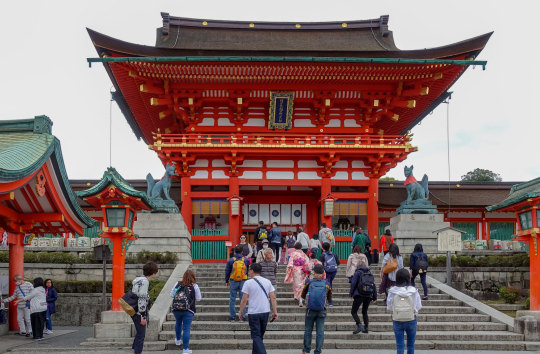
Shinto, also known as Shintoism or kami-no-michi, is a religion originating from Japan. Classified as an East Asian religion by scholars of religion, its practitioners often regard it as Japan's indigenous religion. Scholars sometimes call its practitioners Shintoists, although adherents rarely use that term themselves.
Shinto is polytheistic and revolves around the kami ("gods" or "spirits"), supernatural entities believed to inhabit all things. The link between the kami and the natural world has led to Shinto being considered animistic and pantheistic. The kami are worshiped at kamidana household shrines, family shrines, and public shrines. The latter are staffed by priests who oversee offerings to the kami and the provision of religious paraphernalia such as amulets to the religion's adherents. Other common rituals include the kagura ritual dances, age specific celebrations, and seasonal festivals. These festivals and rituals are collectively called matsuri. A major conceptual focus in Shinto is ensuring purity by cleansing practices of various types including ritual washing or bathing. Shinto does not emphasize specific moral codes other than ritual purity, reverence for kami, and regular communion following seasonal practices. Shinto has no single creator or specific doctrinal text, but exists in a diverse range of localized and regionalised forms.
Belief in kami can be traced to the Yayoi period (1000 BCE to 300 CE), although similar concepts existed already during the Jōmon period (see Ko-Shintō), but their veneration was more simplistic than in later periods. At the end of the Kofun period (300 to 538 CE), Buddhism entered Japan and influenced kami veneration. Through Buddhist influence, kami came to be depicted anthropomorphically and were situated within Buddhist cosmology. Religious syncretisation made kami worship and Buddhism functionally inseparable, a process called Shinbutsu-shūgō. The earliest written tradition regarding kami worship was recorded in the eighth-century Kojiki and Nihon Shoki. In ensuing centuries, Shinbutsu-shūgō was adopted by Japan's Imperial household. During the Meiji era (1868 to 1912 CE), Japan's leadership expelled Buddhist influence from Shinto and formed State Shinto, which they utilized as a method for fomenting nationalism and imperial worship. Shrines came under growing government influence, and the Emperor of Japan was elevated to a particularly high position as a kami. With the formation of the Japanese Empire in the early 20th century, Shinto was exported to other areas of East Asia. Following Japan's defeat in World War II, Shinto was formally separated from the state.

Shinto is primarily found in Japan, where there are around 80,000 public shrines; the country's shrine organization claims 113 million adherents. Shinto is also practiced elsewhere, in smaller numbers. Only a minority of Japanese people identify as religious, although most of the population take part in Shinto matsuri and Buddhist activities, especially festivals, and seasonal events. This reflects a common view in Japanese culture that the beliefs and practices of different religions need not be exclusive. Aspects of Shinto have also been incorporated into various Japanese new religious movements.
1 note
·
View note
Text
Nagomi Town
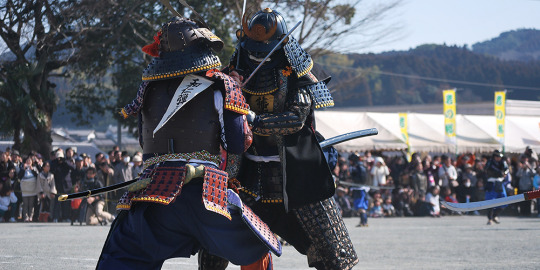
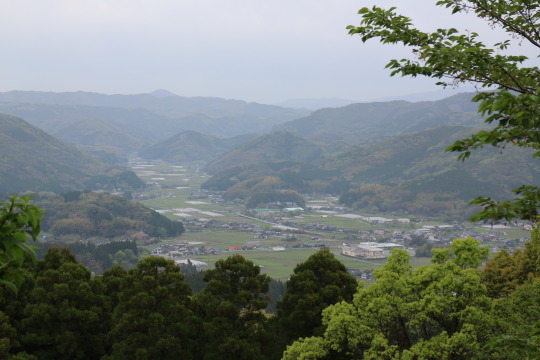


Nagomi Town
Nagomi Town is located in the northwest of Kumamoto Prefecture.
The town was born on March 1, 2006, with the merger of two separate towns: Mikawa and Kikusui.
Situated in the center of Kyushu, Nagomi enjoys good access, with Kikusui Interchange on the Kyushu Expressway in the center of town and other small/medium-sized cites located nearby. The town has rich natural surroundings, including Kikuchi River and verdant mountains, and is also blessed with a variety of historical resources, with highlights including Eta Funayama Kofun burial mound, the site of Tanaka Castle, and Buzen Kaido, the old main route between northern and southern Kyushu.
Nagomi has developed as both a center of agriculture and industry. It is rich in agricultural produce, from rice to vegetables and fruit, while having also successfully enticed many companies to move here, especially those in the fields of electrical appliances and precision machinery.
For relaxing, Higo Folk Village is a fascinating tourist spot, home to a number of traditional Japanese houses steeped in the atmosphere of days gone by. Please stop by and enjoy a moment of tranquility, or perhaps visit the gallery or take part in a workshop (including glassmaking, ceramics, small bamboo flute-making, and woodworking).
#the Northern Kumamoto Tourism Council#Kumamoto prefecture north#Nagomi Town#Eta Funayama Kofun burial mound#Tanaka Castle#Buzen Kaido#Higo Folk Village
0 notes
Text
Tiny Titan Microman: the “Lost Adventures” - Year Two (1977)
(Continued from Year One - see for more details and credits. Special thanks this posting to Christopher Mah and original “Microman Trivia” transcription translated from Tette Hakase at Alpha-7 Laboratory)
Chapter 12: January, 1977
Transfer Fortress is a mobile armed super-fortress that protects the Earth from the enlarged Acroyear menace. The merits of this base are that while its individual parts are fully capable as separate units, they can combine in order to fly from place to place.
In the case of an emergency, there is no need for panic. The pilot seated in the upper module of the base can quickly slide into the cockpit. As everything is automated, it is demonstrably capable in an emergency situation.
The units making up its parts are also capable of handling crises. While not shown in this manga, the front of the base can be ejected to enter combat separately. Each of the parts can dock with each other automatically to become fighters. This is just as one example.
Chapter 13: February, 1977
The secrets of Microman’s origins are wrapped in mystery. As the construction of the ancient Moai megaliths of Easter Island and the enormous Egyptian pyramids seem beyond the means of human construction, it seems possible that Micromen may have been involved.
((Tette Hakase: As our studies of ancient civilization have improved since this time of publication, the answer to this has been shown to not be so simple. Easter Island was once far more densely populated, and it is clear that such construction was not so impossible with coordinated effort. The Egyptian pyramids didn’t just appear at once, but rather it has been shown that they were developed over time with technological innovation. However, many mysteries remain about the grand scale that seems to exceed useful purpose and the meaning behind their construction.))
Surprisingly, near the Republic of Columbia’s capital Bogotá, models of a jet plane were found that were over 3000 years old. These models closely resemble that of an F-102 fighter. Could this also be related to Microman?
((Tette Hakase: These O-Parts became the model for Earth Jetter. Or wait, perhaps we should say that Earth Jetter was the model for these?))
((Microman Club: See http://www.2atoms.com/weird/ancient/plane.htm
Note however that archeologists today believe that these are stylized depictions of fish or birds from the region, and they are similar to other highly stylized artifacts depicting more easily identifiable animals))
There are plenty of mysterious ruins even in Japan. A fresco of a space rocket was discovered at the site of an ancient 3000 year old Kazuwara Kofun burial mound in Shiranuimachi of Kumamoto Prefecture. A rocket that greatly resembles Microman’s Super Jet.
((Tette Hakase: There are line drawings which show the life of ancient mariners of the Yatsushiro Sea, including ships and dolphins, but it is not open for viewing by the public.))
Chapter 14: March, 1977
The Titan’s homeland is the world of Titan, the moon of Saturn. “Many of our companions still lie in slumber there,” were their words which prompted the Spy Magicians to travel to Titan in the Transfer Fortress.
The Spy Magicians that reached Titan began their investigation, and life signs were detected in what their charts showed as a glass valley. The spectral ray was used and the Titans that were revived were extremely robotic and sports car-like in form.
The Spy Magicians dubbed them “Titan Commands” and decided to call the vehicles “Gimca”. They then returned to Earth in order to help solve the issue of the Acroyears and the mysterious ruins around the globe.
Chapter 15: April, 1977
The Spy Magicians’ investigations had revealed that the Acroyears manifested frequently near ancient ruins. In order to understand the relationship between the Acroyears’ supernatural powers and the ancient ruins, the Spy Magicians flew to every corner of the globe.
The Titan Commands which had arrived from Titan, in order to adapt to life on Earth, began training for combining with their Gimca (the vehicles ridden by Titan Command). Currently 4 Titan Commands are active on Earth.
((Tette Hakase: The four Titan Commands would be Type One Jupitas and Poseidar, along with Type Two Tailos and Hercules. Types Three and Four were not introduced yet in Bouken Oh’s manga or advertisements.))
The Titan Commands exhibit supernatural abilities when combined with their Gimca. With 2000 horsepower, they can break past the lightspeed barrier thanks to being equipped with warp drives. Although other Titans can combine with the Gimca, they will not gain these abilities.
Chapter 16: May, 1977
Thousands of years ago, the Microman Commands came to Earth from MicroEarth. The Microman Commands who were active back then have remained asleep due to some unusual phenomenon. In those times, they were the same height as human beings.
((Tette Hakase: What kind of phenomenon? Was it even beyond explanation for the Microman Commands themselves?))
The Spy Magicians, upon learning of the Microman Commands, began to revive these lost comrades one after another from the ancient ruins of mystery such as from the Inca and Egypt. And so thus were the Command corps assembled alongside the Titan Commands.
Analysis of the gas released upon their revival resulted in the detection of a previously unknown element. Labeled αH7 by the Spy Magicians, it was deduced to be connected with the Acroyears’ ability to become gargantuan in size.
Chapter 17: June, 1977

(first two pages of chapter 17 from http://blogs.yahoo.co.jp/mzek81/33640941.html --M113 Bobby, M114 Blacky and the Spy Magicians, joined by Command 1 M152 Eric encounter AcroJet and AcroCannon piloted by Armroids while patrolling in Transfer Fortress at Nazca, Peru)
Acroyears are able to utilize the strange element αH7. This is how they differ as cyborgs from Microman and can become gigantic, as their bodies are covered in αH7. The Micromen are desperate to solve the mystery behind αH7.
((Tette Hakase: Note that in the TV Magazine manga, Professor Katagai’s lab report showed that the Acroyear body is not so much covered in αH7, but rather that αH7 is bound to their cells.)
The Acroyears used αH7 to also combine their forms with vehicles and to become an even more enormous Acroyear. This combines two Acroyears with two vehicles. Unfortunately, currently the Micromen are unable to face it.
The Micromen are gradually gaining insight into the mystery of αH7. Also four new Command Cars have been designed. The four vehicles are Racing Buggy*, Tyrell Machine, Earth Jetter, and Twin Racer. And thus they may yet live to fight on.
((*Racing Buggy image link from MicroEarth website,))
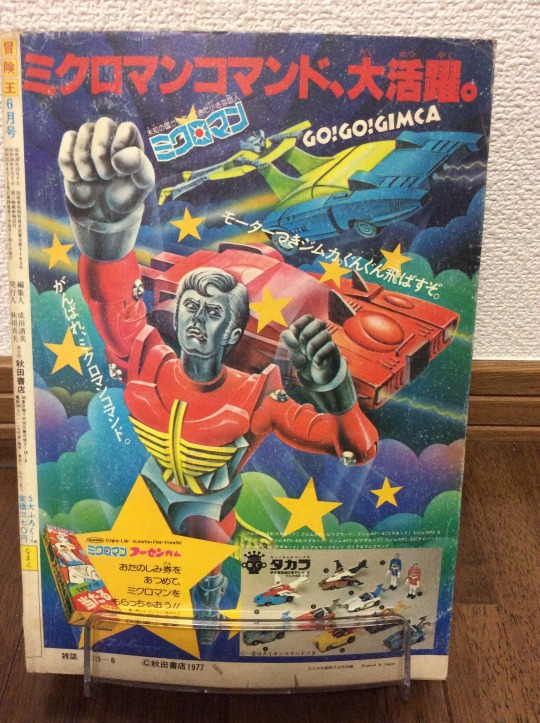
(back page ad from June 1977 Bouken Oh for Microman Command and Titan Command Gimca toys)
Chapter 18: July, 1977
When the Microman Commands arrived at the MCIA (RoadStation), four new Command Cars were designed immediately in order to help discover the answer to the mystery of αH7. In order to enable free and easy mobility around the globe, these were super-machines created expressly for use on Earth.
One of these Command Cars, the Tyrell Machine, was a vehicle that was patterned after the famous Ford Tyrell for optimal high-speed performance. It can reconfigure its body in order for both regular activities as well as to quickly respond to any given situation such as for reconnaissance, combat, etc….
Giant Acroyear’s vital parts are its arms. This is because they themselves are two Acroyears, Acroid Ta (T-A) and Armroid Sh (S-H) which combine with the AcroJet and AcroCannon to form Giant Acroyear.
((Tette Hakase: While here they are called “Acroid” and “Armroid”, this may be that the MCIA had confused some of their intelligence about the true nature of them becoming the two arms. Were they new types of Acroyears, or androids? It wasn’t possible to be certain at first. Even the data about them being the vital points appears to be groundless. The final names turned out to be “Armroid Ta (Tax)” as the left arm which fired a heat ray cannon, and the right arm was “Armroid Sh (Shooter)” which fired a cold ray cannon.))
Chapter 19: August, 1977
The high-performance jet Earth Jetter was designed with the cooperation of Microman Commands who came from Easter Island and Egypt. They brought to bear the past technology of the ancient civilizations they had previously been involved with.
Earth Jetter can mobilize from both the ground and Transfer Fortress. It boasts a maximum speed of mach 1.5, equipped with a hydrogen engine with a performance output of up to 2800 horsepower. It can perform vertical take-off and landing with its twin turbo fans.
Earth Jetter was designed for defending the planet from Acroyears. For that purpose, it can perform vertical climbs directly to outer space, giving it a wide field of operation. In addition, its weapons include both the standard wave motion missile launcher as well as a “Laser Scriper” which can slice through most things.
Chapter 20: September, 1977
So far, by now everyone should know that the Microman Command and development of the Command Cars have been for investigating the mysteries around the Earth of the ancient ruins, but what about the Titan Commands?
The Titan Commands developed the Dash Rail as an extreme training course to further hone their abilities. They began their own impossible regimen in tandem with the Micromen in order to be able to face unexpected attacks from the Acroyears.
The Micromen, even though they are cyborgs, are still living beings. If they were to participate in the Titan Command’s Dash Rail training, they would be crushed flat. The Titans’ bodies are made up entirely of silicon-based cells, which make it possible for them.
Chapter 21: October, 1977
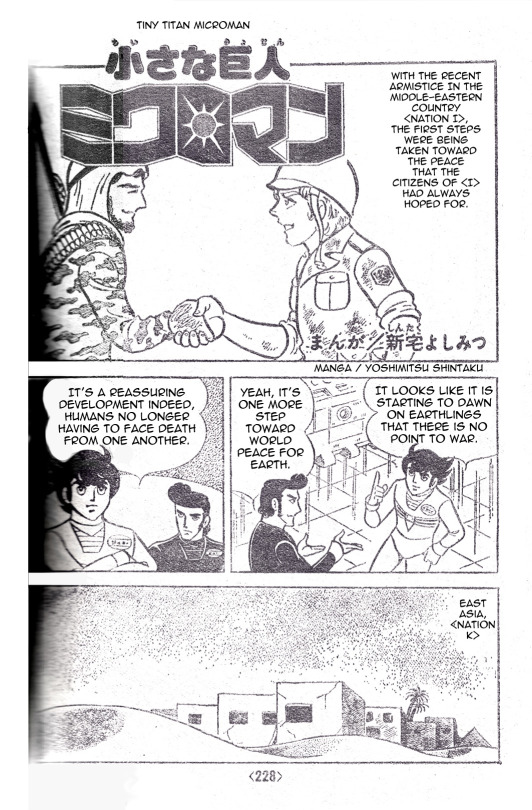

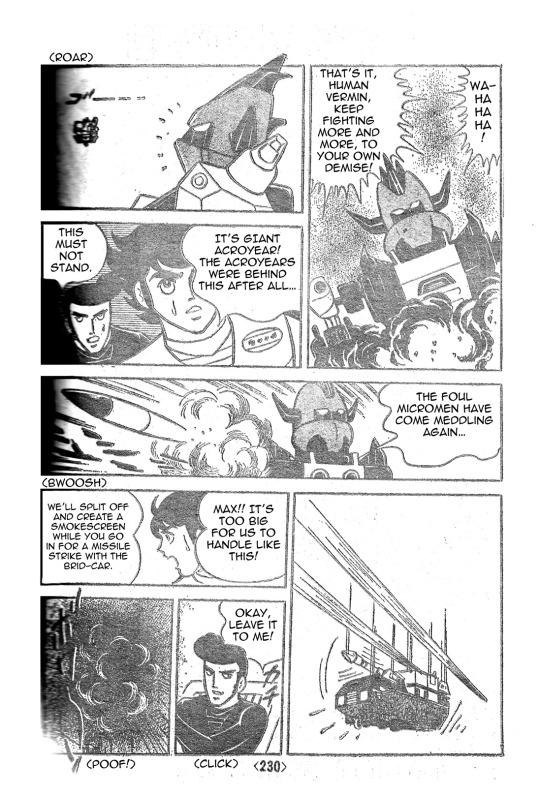
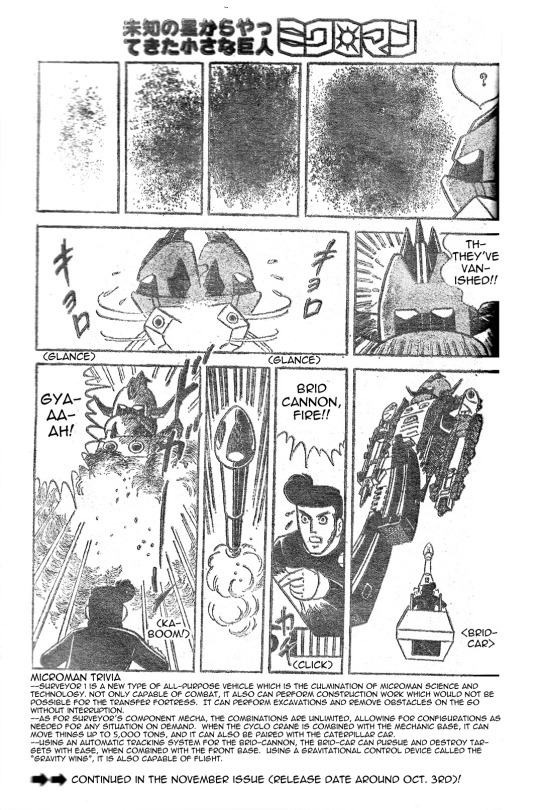
Surveyor 1 is a new type of all-purpose vehicle which is the culmination of Microman science and technology. Not only capable of combat, it also can perform construction work which would not be possible for the Transfer Fortress. It can perform excavations and remove obstacles on the go without interruption.
As for Surveyor’s component mecha, the combinations are unlimited, allowing for configurations as needed for any situation on demand. When the Cyclo Crane is combined with the Mechanic Base, it can move things up to 5,000 tons, and it can also be paired with the Caterpillar Car.
Using an automatic tracking system for the Brid-Cannon, the Brid-Car can pursue and destroy targets with ease, when combined with the Front Base. Using a gravitational control device called the “Gravity Wing”, it is also capable of flight.
Chapter 22: November, 1977
The arsenal of the Acroyears has continued to advance rapidly. After their confidence being boosted by the success of Giant Acroyear, they went on to complete a second robot which included the function of a heavy tank, Mecha Acroyear.
On the other hand, the Micromen caught word of the development of the Mecha Acroyear through the Spy Magicians, and in order to counter it, they commenced development of their own giant combining caterpillar tread robot with ten times the power of Robotman, RobotMachine Z.
Chapter 23: December, 1977
The female Microman that appeared this time was revived from the site of the Statue of Liberty in New York. Like humans on Earth, there were once both males and females who lived on MicroEarth, but this marks their first appearance after arriving on Earth.
It may not come as a surprise that Surveyor 1 was destroyed by Mecha Acroyear. However, do not be afraid. The Micromen have already not only built an even stronger Surveyor 2, but are even now hurrying to complete the Surveyor Base which is capable of traveling into outer space.
(Continued in Year Three...)
#microman#micronauts#takara sf land#bouken oh#Yoshimitsu Shintaku#冒険王#ミクロマン#新宅よしみつ#ミクロマンコマンド#スパイマジシャン#microman command#spy magician#titan command#タイタンコマンド
11 notes
·
View notes
Text
Martial Arts
Koryū bujutsu
Koryū (古流:こりゅう), meaning "traditional school", or "old school", refers specifically to schools of martial arts, originating in Japan, either prior to the beginning of the Meiji Restoration in 1868, or the Haitōrei edict in 1876. In modern usage, bujutsu (武術), meaning military art/science, is typified by its practical application of technique to real-world or battlefield situations.
The term also is used generally to indicate that a particular style or art is "traditional", rather than "modern". However, what it means for an art to be either "traditional" or "modern" is subject to some debate. As a rule of thumb, the primary purpose of a koryū martial art was for use in war. The most extreme example of a koryū school is one that preserves its traditional, and often ancient, martial practices even in the absence of continuing wars in which to test them. Other koryū schools may have made modifications to their practices that reflect the passage of time (which may or may not have resulted in the loss of "koryū" status in the eyes of its peers). This is as opposed to "modern" martial arts, whose primary focus is generally upon the self-improvement (mental, physical, or spiritual) of the individual practitioner, with varying degrees of emphasis on the practical application of the martial art for either sport or self-defence purposes.
The following subsections represent not individual schools of martial arts, but rather generic "types" of martial arts. These are generally distinguishable on the basis of their training methodology and equipment, though wide variation still exists within each.
Sumo
Sumo (相撲:すもう, sumō), considered by many to be Japan's national sport, has its origins in the distant past. The earliest written records of Japan, which are dated from the 8th century AD, record the first sumo match in 23 BC, occurring specifically at the request of the emperor and continuing until one man was too wounded to continue. Beginning in 728 AD, the Emperor Shōmu (聖武天皇, 701–756) began holding official sumo matches at the annual harvest festivals. This tradition of having matches in the presence of the emperor continued, but gradually spread, with matches also held at Shinto festivals, and sumo training was eventually incorporated into military training. By the 17th century, sumo was an organized professional sport, open to the public, enjoyed by both the upper class and commoners.
Today, sumo retains much of its traditional trappings, including a referee dressed as a Shinto priest, and a ritual where the competitors clap hands, stomp their feet, and throw salt in the ring prior to each match. To win a match, competitors employ throwing and grappling techniques to force the other man to the ground; the first man to touch the ground with a part of the body other than the bottom of the feet, or touch the ground outside the ring with any part of the body, loses. Six grand tournaments are held annually in Japan, and each professional fighter's name and relative ranking is published after each tournament in an official list, called the banzuke, which is followed religiously by sumo fans.
Jujutsu[.
Jujutsu (柔術:じゅうじゅつ, jūjutsu), literally translates to "Soft Skills". However, more accurately, it means the art of using indirect force, such as joint locks or throwing techniques, to defeat an opponent, as opposed to direct force such as a punch or a kick. This is not to imply that jujutsu does not teach or employ strikes, but rather that the art's aim is the ability to use an attacker's force against him or her, and counter-attack where they are weakest or least defended.
Methods of combat included striking (kicking, punching), throwing (body throws, joint-lock throws, unbalance throws), restraining (pinning, strangulating, grappling, wrestling) and weaponry. Defensive tactics included blocking, evading, off balancing, blending and escaping. Minor weapons such as the tantō (dagger), ryufundo kusari (weighted chain), jutte (helmet smasher), and kakushi buki (secret or disguised weapons) were almost always included in koryū jujutsu.
Most of these were battlefield-based systems to be practiced as companion arts to the more common and vital weapon systems. At the time, these fighting arts went by many different names, including kogusoku, yawara, kumiuchi, and hakuda. In reality, these grappling systems were not really unarmed systems of combat, but are more accurately described as means whereby an unarmed or lightly armed warrior could defeat a heavily armed and armored enemy on the battlefield. Ideally, the samurai would be armed and would not need to rely on such techniques.
In later times, other koryū developed into systems more familiar to the practitioners of the jujutsu commonly seen today. These systems are generally designed to deal with opponents neither wearing armor nor in a battlefield environment. For this reason, they include extensive use of atemi waza (vital-striking technique). These tactics would be of little use against an armored opponent on a battlefield. They would, however, be quite valuable to anyone confronting an enemy or opponent during peacetime dressed in normal street attire. Occasionally, inconspicuous weapons such as knives or tessen (iron fans) were included in the curriculum.
Today, jujutsu is practiced in many forms, both ancient and modern. Various methods of jujutsu have been incorporated or synthesized into judo and aikido, as well as being exported throughout the world and transformed into sport wrestling systems, adopted in whole or part by schools of karate or other unrelated martial arts, still practiced as they were centuries ago, or all of the above.
Swordsmanship
Swordsmanship, the art of the sword, has an almost mythological ethos, and is believed by some to be the paramount martial art, surpassing all others. Regardless of the truth of that belief, the sword itself has been the subject of stories and legends through virtually all cultures in which it has been employed as a tool for violence. In Japan, the use of the katana is no different. Although originally the most important skills of the warrior class were proficiency at horse-riding and shooting the bow, this eventually gave way to swordsmanship. The earliest swords, which can be dated as far back as the Kofun era (3rd and 4th centuries) were primarily straight bladed. According to legend, curved swords made strong by the famous folding process were first forged by the smith Amakuni Yasutsuna (天國 安綱, c. 700 AD).[8]
The primary development of the sword occurred between 987 AD and 1597 AD. This development is characterized by profound artistry during peaceful eras, and renewed focus on durability, utility, and mass production during the intermittent periods of warfare, most notably civil warfare during the 12th century and the Mongolian invasions during the 13th century (which in particular saw the transition from mostly horseback archery to hand to hand ground fighting).
This development of the sword is paralleled by the development of the methods used to wield it. During times of peace, the warriors trained with the sword, and invented new ways to implement it. During war, these theories were tested. After the war ended, those who survived examined what worked and what didn't, and passed their knowledge on. In 1600 AD, Tokugawa Ieyasu (徳川 家康, 1543–1616) gained total control of all of Japan, and the country entered a period of prolonged peace that would last until the Meiji Restoration. During this period, the techniques to use the sword underwent a transition from a primarily utilitarian art for killing, to one encompassing a philosophy of personal development and spiritual perfection.
The terminology used in Japanese swordsmanship is somewhat ambiguous. Many names have been used for various aspects of the art or to encompass the art as a whole.
Kenjutsu
Kenjutsu (剣術:けんじゅつ) literally means "the art/science of the sword". Although the term has been used as a general term for swordsmanship as a whole, in modern times, kenjutsu refers more to the specific aspect of swordsmanship dealing with partnered sword training. It is the oldest form of training and, at its simplest level, consists of two partners with swords drawn, practicing combat drills. Historically practiced with wooden katana (bokken), this most often consists of pre-determined forms, called kata, or sometimes called kumitachi, and similar to the partner drills practiced in kendo. Among advanced students, kenjutsu training may also include increasing degrees of freestyle practice.
Battōjutsu
Battōjutsu (抜刀術:ばっとうじゅつ), literally meaning "the art/science of drawing a sword", and developed in the mid-15th century, is the aspect of swordsmanship focused upon the efficient draw of the sword, cutting down one's enemy, and returning the sword to its scabbard (saya). The term came into use specifically during the Warring States Period (15th–17th centuries). Closely related to, but predating iaijutsu, battōjutsu training emphasizes defensive counter-attacking. Battōjutsu training technically incorporates kata, but generally consist of only a few moves, focusing on stepping up to an enemy, drawing, performing one or more cuts, and sheathing the weapon. Battōjutsu exercises tend to lack the elaborateness, as well as the aesthetic considerations of iaijutsu or iaidō kata.[citation needed] Finally, note that use of the name alone is not dispositive; what is battōjutsu to one school may be iaijutsu to another.[citation needed]
Iaijutsu
Iaijutsu (居合術:いあいじゅつ), approximately "the art/science of mental presence and immediate reaction", is also the Japanese art of drawing the sword. However, unlike battōjutsu, iaijutsu tends to be technically more complex, and there is a much stronger focus upon perfecting form. The primary technical aspects are smooth, controlled movements of drawing the sword from its scabbard, striking or cutting an opponent, removing blood from the blade, and then replacing the sword in the scabbard.
Naginatajutsu
Naginatajutsu (長刀術:なぎなたじゅつ) is the Japanese art of wielding the naginata, a weapon resembling the medieval European glaive or guisarme. Most naginata practice today is in a modernized form (gendai budō) called the "way of naginata" (naginata-dō) or "new naginata" (atarashii naginata), in which competitions are also held.
However, many koryu maintain naginatajutsu in their curriculum. Also of note, during the late Edo period, naginata were used to train women and ladies in waiting. Thus, most naginatajutsu styles are headed by women and most naginata practitioners in Japan are women. This has led to the impression overseas that naginatajutsu is a martial art that was not used by male warriors. In fact, naginatajutsu was developed in early medieval Japan and for a time was widely used by samurai.[citation needed]
Sōjutsu
Sōjutsu (槍術:そうじゅつ) is the Japanese art of fighting with the spear (yari). For most of Japan's history, sōjutsu was practiced extensively by traditional schools. In times of war, it was a primary skill of many soldiers. Today it is a minor art taught in very few schools.
Shinobi no jutsu/ Ninjutsu
Shinobi no jutsu (aka Ninjutsu) was developed by groups of people mainly from Iga, Mie and Kōka, Shiga of Japan who became noted for their skills as Infiltrators, scouts, secret agents, and spies. The training of these shinobi (ninja) involves espionage, sabotage, disguise, escape, concealment, assassination, archery, medicine, explosives, poisons, black magic, and more.
Gendai budō
Gendai budō (現代武道:げんだいぶどう), literally meaning "modern martial way", usually applies to arts founded after the beginning of the Meiji Restoration in 1868.[citation needed] Aikido and judo are examples of gendai budō that were founded in the modern era, while iaidō represents the modernization of a practice that has existed for centuries.
The core difference is, as was explained under "koryū", above, that koryū arts are practiced as they were when their primary utility was for use in warfare, while the primary purpose of gendai budō is for self-improvement, with self-defense as a secondary purpose. Additionally, many of the gendai budō have included a sporting element to them. Judo and kendo are both examples of this.
Judo
Judo (柔道:じゅうどう, jūdō), literally meaning "gentle way" or "way of softness", is a grappling-based martial art, practiced primarily as a sport. It contains substantially the same emphasis on the personal, spiritual, and physical self-improvement of its practitioners as can be found throughout gendai budō.
Judo was created by Kano Jigoro (嘉納 治五郎 Kanō Jigorō, 1860–1938) at the end of the 19th century. Kano took the koryū martial arts he learned (specifically Kitō-ryū and Tenjin Shin'yo-ryū jujutsu), and systematically reinvented them into a martial art with an emphasis on freestyle practice (randori) and competition, while removing harmful jujutsu techniques or limiting them to the kata. Kano devised a powerful system of new techniques and training methods, which famously culminated on June 11, 1886, in a tournament that would later be dramatized by celebrated Japanese filmmaker Akira Kurosawa (黒沢 明 Kurosawa Akira, 1910–1998), in the film "Sanshiro Sugata" (1943).
Judo became an Olympic sport in 1964, and has spread throughout the world. Kano Jigoro's original school, the "Kodokan", has students worldwide, and many other schools have been founded by Kano's students.
Kendo
Kendo (剣道:けんどう, kendō), meaning the "way of the sword", is based on Japanese sword-fighting.[citation needed] It is an evolution of the art of kenjutsu, and its exercises and practice are descended from several particular schools of swordsmanship. The primary technical influence in its development was the kenjutsu school of Ittō-ryū (founded c. 16th century), whose core philosophy revolved around the concept that all strikes in swordsmanship revolve around the technique kiri-oroshi (vertical downward cut). Kendo really began to take shape with the introduction of bamboo swords, called shinai,[citation needed] and the set of lightweight wooden armour, called bogu, by Naganuma Sirōzaemon Kunisato (長沼 四郎左衛門 国郷, 1688–1767), which allowed for the practice of strikes at full speed and power without risk of injury to the competitors.
Today, virtually the entire[citation needed] practice of kendo is governed by the All Japan Kendo Federation, founded in 1951. Competitions are judged by points, with the first competitor to score two points on their opponent declared the winner. One point may be scored with a successful and properly executed strike to any of several targets: a thrust to the throat, or a strike to the top of the head, sides of the head, sides of the body, or forearms. Practitioners also compete in forms (kata) competitions, using either wooden or blunted metal swords, according to a set of forms promulgated by the AJKF
Iaidō
Iaidō (居合道:いあいどう), which would be "the way of mental presence and immediate reaction", is nominally the modernization of iaijutsu, but in practice is frequently identical to iaijutsu. The replacement of jutsu with dō is part of the 20th century emphasis upon personal and spiritual development; an evolution that took place in many martial arts. In the case of iaidō, some schools merely changed in name without altering the curriculum, and others embraced the wholesale change from a combat-orientation to spiritual growth.
Aikido
Aikido (合氣道:あいきどう, aikidō) means "the way to harmony with ki". It is a Japanese martial art developed by Morihei Ueshiba (植芝 盛平 Ueshiba Morihei, 1883 – 1969). The art consists of "striking", "throwing" and "joint locking" techniques and is known for its fluidity and blending with an attacker, rather than meeting "force with force". Emphasis is upon joining with the rhythm and intent of the opponent in order to find the optimal position and timing, when the opponent can be led without force. Aikidō is also known for emphasizing the personal development of its students, reflecting the spiritual background of its founder.
Morihei Ueshiba developed aikido mainly from Daitō-ryū aiki-jūjutsu incorporating training movements such as those for the yari (spear), jō (a short quarterstaff), and perhaps also juken (bayonet). Arguably the strongest influence is that of kenjutsu and in many ways, an aikidō practitioner moves as an empty handed swordsman.
Kyūdō
Kyūdō (弓道:きゅうどう), which means “way of the bow", is the modern name for Japanese archery. Originally in Japan, kyujutsu, the “art of the bow", was a discipline of the samurai, the Japanese warrior class. The bow is a long range weapon that allowed a military unit to engage an opposing force while it was still far away. If the archers were mounted on horseback, they could be used to even more devastating effect as a mobile weapons platform. Archers were also used in sieges and sea battles.
However, from the 16th century onward, firearms slowly displaced the bow as the dominant battlefield weapon. As the bow lost its significance as a weapon of war, and under the influence of Buddhism, Shinto, Daoism and Confucianism, Japanese archery evolved into kyudō, the “way of the bow". In some schools kyudō is practiced as a highly refined contemplative practice, while in other schools it is practiced as a sport.
Karate
Karate (空手, karate) literally means "empty hand". It is also sometimes called "the way of the empty hand" (空手道, karatedō). It was originally called 唐手 ("Chinese hand"), also pronounced 'karate'.
Karate originated in and, is technically, Okinawan, except for Kyokushin (an amalgamation of parts of Shotokan and Gojoryu), formerly known as the Ryūkyū Kingdom, but now a part of present-day Japan. Karate is a fusion of pre-existing Okinawan martial arts, called "te", and Chinese martial arts. It is an art that has been adopted and developed by practitioners on the Japanese main island of Honshu.
Karate's route to Honshu began with Gichin Funakoshi (船越 義珍 Funakoshi Gichin, 1868–1957), who is called the father of karate, and is the founder of Shotokan karate. Although some Okinawan karate practitioners were already living and teaching in Honshū, Funakoshi gave public demonstrations of karate in Tokyo at a physical education exhibition sponsored by the ministry of education in 1917, and again in 1922. As a result, karate training was subsequently incorporated into Japan's public school system. It was also at this time that the white uniforms and the kyū/dan ranking system (both originally implemented by judo's founder, Kano Jigoro) were adopted.
Karate practice is primarily characterized by linear punching and kicking techniques executed from a stable, fixed stance. Many styles of karate practiced today incorporate the forms (kata) originally developed by Funakoshi and his teachers and many different weapons traditionally concealed as farm implements by the peasants of Okinawa. Many karate practitioners also participate in light- and no-contact competitions while some (ex. kyokushin karate) still compete in full-contact competitions with little or no protective gear.
Shorinji Kempo
Shorinji Kempo (少林寺拳法, shōrinji-kenpō) is a post-World War II system of self-defense and self-improvement training (行: gyo or discipline) known as the modified version of Shaolin Kung Fu. There are two primary technique categories such as gōhō (strikes, kicks and blocks) and jūhō (pins, joint locks and dodges). It was established in 1947 by Doshin So (宗 道臣, Sō Dōshin) who had been in Manchuria during World War II and who on returning to his native Japan after World War II saw the need to overcome the devastation and re-build self-confidence of the Japanese people on a massive scale.
Although Shorinji Kempo was originally introduced in Japan in the late 1940s and 1950s through large scale programmes involving employees of major national organizations (e.g. Japan Railways) it subsequently became popular in many other countries. Today, according to the World Shorinji Kempo Organization (WSKO), there are almost 1.5 million practitioners in 33 countries.
0 notes